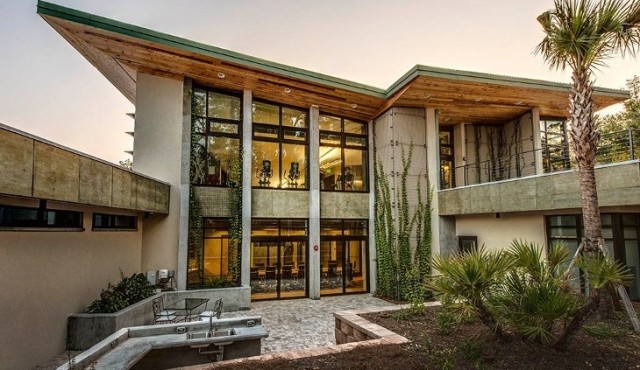There Are No Drawbacks to Giving Your Employees a Living Wage – Just Ask Ken LaRoe

Ever since the Great Recession, banks have taken up a sinister place in the American imaginary. When you read the word “bankers,” there’s a good chance that it summons visions of Wolf of Wall Street-style greed and debauchery.
Ken LaRoe, CEO of First Green Bank, knows this – but he also knows that it’s not the whole story.
“When society as a whole thinks of banks, they think of the high-paid executives, but they don’t consider that we have tellers, we have couriers – we have a lot of blue-collar workers [on staff],” LaRoe says.
As a founding member of the North American chapter of the Global Alliance for Banking on Values (GABV), LaRoe has long been acutely aware of pay disparities both within banks themselves and within the wider world. A lot of European banks are members of the GABV, and LaRoe says their focus on income inequality has played a role in his own awareness of pay gaps.
“The Europeans are far more in tune with income disparity … to the point where there will be a societal revolt if a CEO is making too much – quite the opposite of America,” LaRoe says. “It made me start thinking about the whole equation.”
LaRoe was thinking about pay disparities in 2014 when the Department of Labor (DOL) published a report on living wages. Curious, LaRoe asked his HR director to pull up the numbers for central Florida, where First Green Bank is located. LaRoe found that, according to the DOL, a living wage in his area was about $29,000 a year.
The problem: The lowest paid employees at First Green bank were making about $23,000. LaRoe was shocked.
“We had people working for us who weren’t even making a living wage,” LaRoe says, a note of regret in his voice. “That’s just not right.”
LaRoe wanted to right this wrong, so he calculated how much it would cost the company to raise the minimum wage at First Green Bank to $30,000 a year. The result: It would cost only $64,000 a year.
LaRoe liked those numbers, and he was ready to institute a living wage at First Green Bank.
Minimum Wage Vs. Living Wage
Before going any further, it’s useful to point out that there is a difference between a “minimum wage” and “living wage.”
A minimum wage is simply the lowest wage that an employer is legally allowed to pay its employees. The minimum wage varies state to state in the U.S. The federal minimum wage is $7.25 per hour, and in states where the minimum wage is lower than that, employees are entitled to receive the federal rate instead of the state’s rate. Essentially, an employer can’t pay its employees less than $7.25 an hour, even if the state’s minimum wage is lower than that.

First Green Bank’s Mount Dora Branch
A living wage, on the other hand, is a wage that allows its earner “to meet minimum standards of living,” according to Dr. Amy K. Glasmeier of MIT. A living wage is the amount a person would need to earn in order to adequately provide the basic necessities, such as food, shelter, and health care, for themselves and their family. What constitutes a living wage varies according to a person’s location, because the cost of living varies according to a person’s location. A living wage in New Jersey is not the same as a living wage in Pennsylvania – nor is a living wage in Monmouth County, New Jersey, the same as a living wage in Hudson County, New Jersey.
There is often a sizable gap between the minimum wage and the living wage in an area, as Dr. Glasmeier’s living wage calculator shows. Because First Green Bank’s headquarters resides in Orlando, Florida, we’ll us this area to illustrate:
– Minimum wage in Orlando: $7.93 per hour
– Living wage in Orlando: $24.02 per hour (for a family of four with one parent working)
So, the minimum wage in Orlando is $16.09 lower than the living wage. In fact, the minimum wage in Florida isn’t even enough to support one childless and unmarried adult: the living wage in that scenario would be $11.13 per hour, which is $3.20 higher than the minimum wage.
(If you want to explore the disparity between living and minimum wages a little more, The Atlantic has an excellent interactive map available, which is based in Dr. Glasmeier’s living wage calculator.)
Rolling Out a Living Wage Program
LaRoe immediately brought his idea to the management team. At first, they thought he was crazy.
“That will cost us a lot of money,” they cried.
But LaRoe shared the numbers with them, and the management team was easily pacified.
Next, LaRoe went to the board. He was able to talk the board members into instituting a living wage with relative ease as well, and in October 2014, First Green Bank’s new living wage was rolled out.
At first, employees didn’t react the way LaRoe expected them to.
“I announced it at a staff meeting. I expected them to cheer and clap, but everyone in the room looked at me like I had antlers. Some of them got ashen,” LaRoe recalls. “And I thought, ‘What’s going on? Why aren’t they celebrating?'”
LaRoe believes the employees were initially in a state of shock – this was a major announcement, after all. With a little more explanation, the atmosphere in the room slowly changed. Eventually, employees warmed up. They started clapping. They started cheering.
“And then they started looking around,” LaRoe says. “They were wondering who just got a raise.”
The (Single and Easily Solved) Challenge of Implementing a Living Wage
When I ask LaRoe if he had run into any challenges rolling out his living wage program, his response is simply, “No.”

Ken LaRoe, CEO of First Green Bank
At first, anyway. After a few seconds of silence, he notes the one challenge that he did face: “There was a potential disparity for the guy or gal making $31,000. Suddenly, their coworker gets an $8,000 raise and they don’t get anything.”
This could have been a recipe for disaster. It could have led to skyrocketing turnover rates and plummeting levels of employee engagement as workers who didn’t receive a sudden windfall looked at their colleagues who did and shook their heads in disgust.
Except, that didn’t happen. First Green Bank addressed the issue before it even had a chance to become as serious problem.
“We just adjusted the normal raises people would have gotten that year to account for it,” LaRoe says. “So, if someone was scheduled to get a 4 percent raise, we brought parity by giving them that, plus an extra big bump.”
‘The Most Impactful Thing We’ve Ever Done’
That’s how LaRoe describes the living wage program. He notes that it has had an especially huge impact on First Green Bank’s recruiting efforts. The company has used it as a selling point for its employer brand, and the results have been excellent.
“You post a job for a teller, and the starting wage is $30,000. You get people out of other industries applying for that job,” LaRoe says. “The quality of applicant is so much higher than it was before. We’re on everybody’s radar. They want to come work here.”
LaRoe also says the living wage initiative has made the management team more efficient, too. Now that the lowest paid employees make such significant salaries, the company thinks long and hard before adding new positions or opening new roles. As a result, no superfluous hires are made, and no money is wasted on employees the bank doesn’t actually need.
“If someone says, ‘Let’s add a position here,’ we all sit back and go, ‘Is it worth $30,000?'” LaRoe explains. “It has forced us to be efficient.”
LaRoe has also decided that he doesn’t want the living wage to stagnate. He doesn’t want to be in a position where his employees are making less than they need to live well – and so, in October of 2015, he raised the company’s minimum wage from $30,000 to $31,000. He plans on continuing to raise the minimum wage at First Green Bank $1000 a year, every year from now on – “Until we can’t pay for it anymore,” he says.

